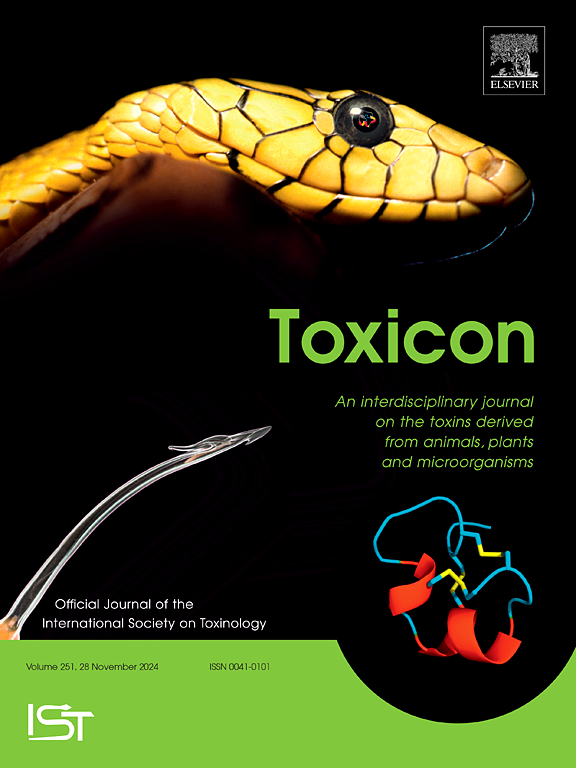The actions of varenicline on alkaloids from Conium maculatum (poison hemlock), Lupinus sulphureus (sulphur lupine) and Nicotiana glauca (tree tobacco)
IF 2.6
4区 医学
Q2 PHARMACOLOGY & PHARMACY
引用次数: 0
Abstract
Evidence-based therapies to manage the clinical signs of intoxication caused by toxic plants in livestock are lacking. For that reason, the aim of this work was to develop a drug-based intervention for the management of clinical signs of piperidine alkaloid intoxication in livestock. The actions of anabasine, coniine, γ-coniceine, and two total alkaloid extracts from Lupinus sulphureus were compared in the presence and absence of the nicotinic acetylcholine receptor partial agonist varenicline in RD cells, mice and goats. Pretreatment of RD cells with 10.0 μM varenicline significantly shifted the anabasine fifty percent effective concentration (EC50) value to a greater concentration and blocked the response of the cells to coniine. γ-coniceine did not have any effect on RD cells as measured by membrane potential sensing dye. Swiss Webster mice median lethal dose (LD50) values for anabasine, coniine, γ-coniceine were 1.5, 5.5, and 3.7 mg/kg respectively, and pretreatment with 10.0 mg/kg i. p. dosed varenicline shifted the LD50 values to 4.2, 9.1, and 4.3 mg/kg respectively. The rodent LD50 value of the Pendelton, WA L. sulphureus quinolizidine alkaloid extract was shifted to a lesser concentration by varenicline while the Ritzville, WA L. sulphureus piperidine alkaloid extract was shifted to a greater concentration by varenicline. The clinical signs of intoxication in goats orally dosed with Conium maculatum were exacerbated by 0.5, 1.0 and 10.0 mg/kg i. v. dosed varenicline. These results suggest that varenicline was effective at shifting piperidine alkaloid EC50 values in RD cells and increasing piperidine but not quinolizidine alkaloid LD50 values in mice and was not useful at managing the clinical signs of poison hemlock intoxication in goats.

伐尼克兰对毒芹(Conium maculatum)、硫磺羽扇豆(Lupinus sulphureus)和烟草(Nicotiana glauca)生物碱的作用。
目前还缺乏循证疗法来控制有毒植物引起的家畜中毒的临床症状。因此,这项工作的目的是开发一种基于药物的干预措施,用于控制牲畜哌啶生物碱中毒的临床症状。在有烟碱乙酰胆碱受体部分激动剂伐尼克兰和没有伐尼克兰的情况下,比较了安那巴辛、柯尼辛、γ-柯尼辛和两种羽扇豆碱总生物碱提取物对 RD 细胞、小鼠和山羊的作用。用 10.0 μM varenicline 对 RD 细胞进行预处理后,阿那巴新 50% 有效浓度(EC50)值明显向更高浓度移动,并阻断了细胞对 coniine 的反应。瑞士韦伯斯特小鼠的阿那巴辛、柯尼因和γ-coniceine的中位致死剂量(LD50)值分别为1.5、5.5和3.7毫克/千克,用10.0毫克/千克剂量的伐伦克林进行预处理后,LD50值分别变为4.2、9.1和4.3毫克/千克。西澳大利亚州 Pendelton 的 L. sulphureus 喹嗪生物碱提取物的啮齿动物半数致死剂量值被伐伦克林改变为较低浓度,而西澳大利亚州 Ritzville 的 L. sulphureus 哌啶生物碱提取物的半数致死剂量值被伐伦克林改变为较高浓度。0.5、1.0 和 10.0 毫克/千克静脉注射伐伦克林会加重山羊口服孔雀石绿中毒的临床症状。这些结果表明,伐尼克兰能有效改变哌啶类生物碱在 RD 细胞中的半数致死浓度值,增加哌啶类生物碱在小鼠体内的半数致死浓度值,但不能增加喹嗪类生物碱在小鼠体内的半数致死浓度值。
本文章由计算机程序翻译,如有差异,请以英文原文为准。
求助全文
约1分钟内获得全文
求助全文
来源期刊

Toxicon
医学-毒理学
CiteScore
4.80
自引率
10.70%
发文量
358
审稿时长
68 days
期刊介绍:
Toxicon has an open access mirror Toxicon: X, sharing the same aims and scope, editorial team, submission system and rigorous peer review. An introductory offer Toxicon: X - full waiver of the Open Access fee.
Toxicon''s "aims and scope" are to publish:
-articles containing the results of original research on problems related to toxins derived from animals, plants and microorganisms
-papers on novel findings related to the chemical, pharmacological, toxicological, and immunological properties of natural toxins
-molecular biological studies of toxins and other genes from poisonous and venomous organisms that advance understanding of the role or function of toxins
-clinical observations on poisoning and envenoming where a new therapeutic principle has been proposed or a decidedly superior clinical result has been obtained.
-material on the use of toxins as tools in studying biological processes and material on subjects related to venom and antivenom problems.
-articles on the translational application of toxins, for example as drugs and insecticides
-epidemiological studies on envenoming or poisoning, so long as they highlight a previously unrecognised medical problem or provide insight into the prevention or medical treatment of envenoming or poisoning. Retrospective surveys of hospital records, especially those lacking species identification, will not be considered for publication. Properly designed prospective community-based surveys are strongly encouraged.
-articles describing well-known activities of venoms, such as antibacterial, anticancer, and analgesic activities of arachnid venoms, without any attempt to define the mechanism of action or purify the active component, will not be considered for publication in Toxicon.
-review articles on problems related to toxinology.
To encourage the exchange of ideas, sections of the journal may be devoted to Short Communications, Letters to the Editor and activities of the affiliated societies.
 求助内容:
求助内容: 应助结果提醒方式:
应助结果提醒方式:


